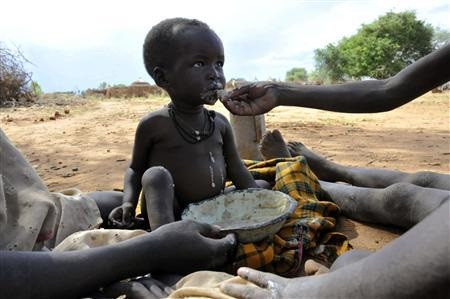Over 200 children die from malnutrition or lack of proper nutrition every year in the Karamoja, especially in the districts of Moroto and Kaabong, health officials in the Karamoja sub-region have said.
The deaths are linked to lack of nutritious foods and the gripping levels of poverty in the region. According to the annual Integrated Phase Classification (IPC) report, about 520,000 people are in dire need of health care including nearly 200,000 under the age of five. The global acute malnutrition (GAM) rate among children less than five years old has increased from 9.7 percent in 2020 to 10.7 percent in 2022.
Rebecca Kwagala, the head of the United Nations Children’s Fund (UNICEF), Karamoja region, said the prevalence of GAM among children in Karamoja stands at 13.1 percent; 21.9 and 19.6 percent in Moroto and Kaabong districts.
“A total of 22,740 children with severe wasting in the region require urgent treatment. Despite the projected number of cases of children with severe wasting in the region, only 24.7 percent (6,238) have been reached with treatment between January and March 2022,” she said.
Moroto district
Onyang Charles Omuudu, the Moroto district nutritionist, said most children have one meal a day which is unacceptable by the World Health Organisation (WHO) standards.
“A child is supposed to take five food groups out of the eight that are recommended. Only 7.9 percent of children are getting the recommended dietary meals, 18.8 percent can take more than one meal a day. Children are falling sick and dying every other day and therefore we need immediate interventions,” he said.
He said only 16.4 percent of women diversify their meals. About 83.6 percent of the women who feed on one food group give birth to stunted children and that affects their performance in schools.
“We have a problem of malaria; diarrhea; respiratory infections; the burden of tuberculosis in the district. Something must be done to avert these problems,” he said, adding, “There is something positive in terms of breastfeeding. Our women have a good practicing culture although it is not on the national standard. 61 percent of children are exclusively breastfed up to six months, 95.5 percent of the children are breastfed up to one year.”
Dr Steven Mpade, the director of Moroto regional referral hospital, said cases of malnutrition are so high in the nine districts in the Karamoja sub-region. Over 200 children die every year. The situation is worse in Kaabong and Moroto districts.
The rising numbers of malnutrition are linked to the dry spell experienced last year that wiped out most livestock and crops and the men’s attitude of abandoning their duties and over-dependence on donors.
“Access to clean water stands at 20 percent in the region and therefore hand washing is a challenge. Over 52 percent practice open defecation and this contributes to the transmission of diarrheal infections,” he said, adding, “They need to be sensitized and helped to live independent lives. They should be engaged in ongoing government programs like Operation Wealth Creation (OWC) and other startups for them to be productive.”
Despite the acute cases in the region, Dr Mpande said they have sensitized the masses about malnutrition in the region. The government of Uganda, Unicef, and other development partners have injected close to Shs 1 billion into the mass screen exercise. We have ensured that malnourished children are identified and severe cases are admitted and given adequate treatment. Because of limited resources, we are still in two districts; however, the mass screen exercise will be rolled out in other districts.
Kaabong District officials Dr. Sharif Nalibe, the district health officer (DHO) of Kaabong district, said the nutrition situation in the area, according to WHO standards, has been classified as critical.
Last year, the GAM rate in Kaabong stood at 18.6 percent, from 7.8 percent in 2020. This year the GAM rate in the district is currently at 19.6 percent and most of the children are anemic.
According to a survey conducted by Unicef, the rate at which children exclusively breastfeed has greatly reduced. Children who were exclusively breastfed were 67.9 percent last year compared to this year’s 48.5 percent. This indicates that the situation is gradually becoming worse.
Childhood infections such as malaria and diarrhea are on the rise in the district. The prevalence of malaria in children under five years is high. About 50 percent of the children who visit health facilities have malaria.
“We lose more than 100 children to malnutrition and many die within the community; the number is slightly more,” he said and urged parents to bring malnourished children to health facilities for medical care.
He said there are interventions made such as deworming of children under the age of 14 and the coverage has gone above 80 percent; Vitamin A supplements are given to children at the age of six months to 59 months and community outreaches and sensitization.
If you would like your article/opinion to be published on Uganda’s most authoritative news platform, send your submission on: [email protected]. You can also follow DailyExpress on WhatsApp and on Twitter (X) for realtime updates.



